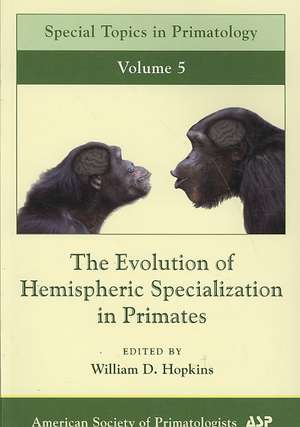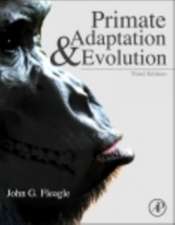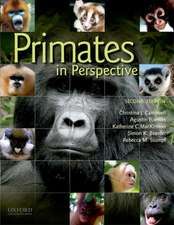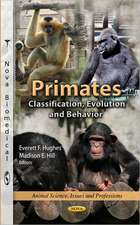The Evolution of Hemispheric Specialization in Primates: Special Topics in Primatology, cartea 5
Editat de William D. Hopkinsen Limba Engleză Paperback – 18 sep 2007
* The first treatment of this important topic since 1998* Examines the tenet that lateralization and handedness is a uniquely human character through evidence from higer and lower primates and with reference to other vertebrates.* Advances our understanding of the occurrence, evolution and significance of lateralization and handedness effects.
Preț: 424.61 lei
Nou
Puncte Express: 637
Preț estimativ în valută:
81.27€ • 88.31$ • 68.31£
81.27€ • 88.31$ • 68.31£
Carte tipărită la comandă
Preluare comenzi: 021 569.72.76
Specificații
ISBN-13: 9780123741974
ISBN-10: 0123741971
Pagini: 312
Ilustrații: Illustrated
Dimensiuni: 152 x 229 x 17 mm
Greutate: 0.42 kg
Editura: ELSEVIER SCIENCE
Seria Special Topics in Primatology
ISBN-10: 0123741971
Pagini: 312
Ilustrații: Illustrated
Dimensiuni: 152 x 229 x 17 mm
Greutate: 0.42 kg
Editura: ELSEVIER SCIENCE
Seria Special Topics in Primatology
Public țintă
Primatologists, Evolutionary Biologists, Neuro-behaviourists, and Behavioural Psychologists at advanced student and research levelCuprins
1)Evaluating Genetic and Non-Genetic Models of Handedness in Non-human Primates - William D. Hopkins,
2)Great Ape Handedness - Richard Byre
3)A Comparison of Laterality in Primates and Non-Primates - Leslie Rogers
4)Prosimian functional laterality - Sheree Watson & Jeanette Ward
5)Neuroanatomical Asymmetries in Non-Human Primates - Claudio Cantalupo
6)The Influence of Prenatal Hormones on the Development of Laterality in Monkeys - Greg Westergaard
7)Evolution and Genetics of Handedness in Humans - Michael Corballis
8)Laterality and Cognition in Split-Brain Monkeys - Charles Hamilton & Betty Vermiere
9)Grip morphology and Hand Use in Primates - Marianne Christel
10)Postural Origins of Laterality Revisited. - Peter MacNeilage
11)Handedness in New World Monkeys with Special Reference to Capuchin monkeys - Giovanni Spinozzi
12)Asymmetries in Facial Expressions and Emotions in Primates - Lisa Parr & Samuel Fernanadez-Carriba
13)Morphological Asymmetries in Early Hominids - Ralph Holloway
14)Brain Asymmetries in Primates as Revealed from Endocasts - Dean Falk
15)Evolution of the Corpus Callosum From a Comparative Primate Perspective - Jim Rilling
16)The Development of Hemispheric Specialization in Human and Nonhuman Primates - Kim Bard
2)Great Ape Handedness - Richard Byre
3)A Comparison of Laterality in Primates and Non-Primates - Leslie Rogers
4)Prosimian functional laterality - Sheree Watson & Jeanette Ward
5)Neuroanatomical Asymmetries in Non-Human Primates - Claudio Cantalupo
6)The Influence of Prenatal Hormones on the Development of Laterality in Monkeys - Greg Westergaard
7)Evolution and Genetics of Handedness in Humans - Michael Corballis
8)Laterality and Cognition in Split-Brain Monkeys - Charles Hamilton & Betty Vermiere
9)Grip morphology and Hand Use in Primates - Marianne Christel
10)Postural Origins of Laterality Revisited. - Peter MacNeilage
11)Handedness in New World Monkeys with Special Reference to Capuchin monkeys - Giovanni Spinozzi
12)Asymmetries in Facial Expressions and Emotions in Primates - Lisa Parr & Samuel Fernanadez-Carriba
13)Morphological Asymmetries in Early Hominids - Ralph Holloway
14)Brain Asymmetries in Primates as Revealed from Endocasts - Dean Falk
15)Evolution of the Corpus Callosum From a Comparative Primate Perspective - Jim Rilling
16)The Development of Hemispheric Specialization in Human and Nonhuman Primates - Kim Bard









